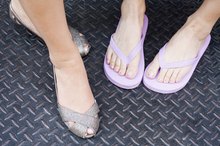5 Things You Need to Know About a Bruised Heel
**With every step you take, the whole weight of your body presses on your heels.
If you are experiencing serious medical symptoms, seek emergency treatment immediately.
** It is not surprising that this may lead to heel problems, like a bruised heel.
Although bruised heels are rarely serious, they can cause a significant amount of pain, especially when walking. Knowing more about this condition will help you recognize the symptoms and learn how to treat it.
It's All About the Heel Pad
Beneath the heel bone — called the calcaneus — sits the heel pad. This soft area contains mostly fat. It acts as a shock-absorbing cushion, protecting the calcaneus as you walk.
When the heel pad becomes damaged, tiny blood vessels can break, forming a bruise. This produces a bruised heel, also known as a heel pad contusion or heel pad syndrome.
At times the heel pad is injured by walking on a stone or similar object that causes sudden bruising. When this occurs, the condition may be called a stone bruise.
More commonly, the heel pad is damaged gradually by the heel repeatedly striking the ground during daily activities. Repeated damage can cause chronic inflammation and thinning of the heel pad, which makes it even more susceptible to further damage.
- Beneath the heel bone — called the calcaneus — sits the heel pad.
- This produces a bruised heel, also known as a heel pad contusion or heel pad syndrome.
Jumping Sports and Other Factors Increase Your Risk
Symptoms of Bone Spur in the Foot
Learn More
Repeated force on the bottom of your heels increases your risk of developing a bruised heel.
This may occur if you walk long distances for long periods on a daily basis. For this reason, yet another name for a bruised heel is “policeman’s heel.”
Sports activities that involve repeated forceful impact on the heel also increase your risk. Long jumpers, high jumpers, basketball or tennis players and long distance runners or power walkers are particularly susceptible. Being overweight causes more weight to land on your heels, increasing the possibility of a bruised heel.
The heel pad may become thinner as part of the natural aging process, placing older people at increased risk of a bruised heel. Walking around with bare feet increases the chances of stepping on a stone or other object, producing a sudden bruised heel.
- Repeated force on the bottom of your heels increases your risk of developing a bruised heel.
- Walking around with bare feet increases the chances of stepping on a stone or other object, producing a sudden bruised heel.
Heel Pain Is Expected
A bruised heel typically causes pain deep within the middle of the heel. The pain improves with rest, so it is often better in the morning but worsens as the day goes on. Standing and walking will make the pain worse.
If you are uncertain whether you have a bruised heel, take the painful foot in your hands and press gently on the middle of your heel with the pads of your thumbs. Increase the pressure steadily until you feel pain.
If the pain is sharp and then decreases when you release the heel, you may have a bruised heel. Pain from a bruised heel can last for weeks.
Because the bruise occurs deep within the heel pad, you usually will not be able to see it. Sometimes the heel pad becomes swollen, but this is uncommon.
- A bruised heel typically causes pain deep within the middle of the heel.
- Because the bruise occurs deep within the heel pad, you usually will not be able to see it.
Other Conditions May Cause Similar Symptoms
What Causes Pain to the Back of Your Ankle & Heel When You Walk?
Learn More
A bruised heel is sometimes confused with plantar fasciitis — inflammation of the fibrous tissue located between the heel and ball of the foot.
But in plantar fasciitis, the pain is typically located at the front of the heel and extends along the sole of the foot towards the toes 1. It is also usually worse in the morning and improves during the day.
Fractures of the calcaneus can cause pain similar to a bruised heel, but the pain will be more severe and continue until the bone heals.
Tiny breaks in the surface of the calcaneus can occur with repeated force on the heel if the heel pad becomes so thin that it no longer acts as an effective cushion.
An acute injury, such as landing on the heel during a fall, can cause a true fracture. This is most common in older adults whose bones have been weakened by osteoporosis.
- A bruised heel is sometimes confused with plantar fasciitis — inflammation of the fibrous tissue located between the heel and ball of the foot.
- Fractures of the calcaneus can cause pain similar to a bruised heel, but the pain will be more severe and continue until the bone heals.
Treatment Relies on Rest
Resting your heel by limiting your walking is an important way to treat a bruised heel. Sports activities that involve forceful landing on the heel should be avoided until symptoms disappear.
Substituting activities like swimming can help maintain fitness when other activities are restricted. Applying ice or a warm compress and taking over-the-counter anti-inflammatory medications such as ibuprofen (Advil, Motrin) or naproxen (Aleve) can be useful. Taping the heel and wearing heel inserts or footwear with good support are other ways to treat a bruised heel.
- Resting your heel by limiting your walking is an important way to treat a bruised heel.
- Sports activities that involve forceful landing on the heel should be avoided until symptoms disappear.
Related Articles
References
- Journal of Bone and Joint Surgery (British): The Heel Pad in Plantar Heel Pain
- Sports & Exercise Injuries: Conventional, Homeopathic & Alternative Treatments; Steven I. Subotnick
- American Family Physician: Diagnosis of Heel Pain
- American Family Physician: Diagnosing Heel Pain in Adults
- American Academy of Orthopedic Surgeons. (2017). Heel Pain. https://orthoinfo.aaos.org/en/diseases--conditions/heel-pain
- Tu P, Bytomski JR. Diagnosis of Heel Pain. Am Fam Physician. 2011 Oct 15;84(8):909-16. https://www.aafp.org/afp/2011/1015/p909.html
- Tu P, Bytomski JR. Diagnosis of heel pain. Am Fam Physician. 2011;84(8):909-16.
- Lim AT, How CH, Tan B. Management of plantar fasciitis in the outpatient setting. Singapore Med J. 2016;57(4):168-70. doi:10.11622/smedj.2016069
- Li HY, Hua YH. Achilles Tendinopathy: Current Concepts about the Basic Science and Clinical Treatments. Biomed Res Int. 2016;2016:6492597. doi:10.1155/2016/6492597
- Gulati V, Jaggard M, Al-nammari SS, et al. Management of achilles tendon injury: A current concepts systematic review. World J Orthop. 2015;6(4):380-6. doi:10.5312/wjo.v6.i4.380
- Hong CH, Lee YK, Won SH, Lee DW, Moon SI, Kim WJ. Tarsal tunnel syndrome caused by an uncommon ossicle of the talus: A case report. Medicine (Baltimore). 2018;97(25):e11008. doi:10.1097/MD.0000000000011008
- Mayer SW, Joyner PW, Almekinders LC, Parekh SG. Stress fractures of the foot and ankle in athletes. Sports Health. 2014;6(6):481-91. doi:10.1177/1941738113486588
- Tu P. Heel Pain: Diagnosis and Management. Am Fam Physician. 2018;97(2):86-93.
- Yi TI, Lee GE, Seo IS, Huh WS, Yoon TH, Kim BR. Clinical characteristics of the causes of plantar heel pain. Ann Rehabil Med. 2011;35(4):507-13. doi:10.5535/arm.2011.35.4.507
- Kucuksen S, Karahan AY, Erol K. Haglund syndrome with pump bump. Med Arch. 2012;66(6):425-7.
- Vaishya R, Agarwal AK, Azizi AT, Vijay V. Haglund's Syndrome: A Commonly Seen Mysterious Condition. Cureus. 2016;8(10):e820. doi:10.7759/cureus.820
- Pękala PA, Henry BM, Pękala JR, Piska K, Tomaszewski KA. The Achilles tendon and the retrocalcaneal bursa: An anatomical and radiological study. Bone Joint Res. 2017;6(7):446-451. doi:10.1302/2046-3758.67.BJR-2016-0340.R1
- Helgeson K. Examination and intervention for sinus tarsi syndrome. N Am J Sports Phys Ther. 2009;4(1):29-37.
- Ma DL, Vano-galvan S. Piezogenic pedal papules. CMAJ. 2013;185(18):E847. doi:10.1503/cmaj.121963
- Fritz JM, Mcdonald JR. Osteomyelitis: approach to diagnosis and treatment. Phys Sportsmed. 2008;36(1):nihpa116823. doi:10.3810/psm.2008.12.11
- Yan L, Zong J, Chu J, et al. Primary tumours of the calcaneus. Oncol Lett. 2018;15(6):8901-8914. doi:10.3892/ol.2018.8487
- Narváez JA, Narváez J, Ortega R, Aguilera C, Sánchez A, Andía E. Painful heel: MR imaging findings. Radiographics. 2000;20(2):333-52. doi:10.1148/radiographics.20.2.g00mc09333
- Thomas JL, Christensen JC, Kravitz SR, et al. The diagnosis and treatment of heel pain: a clinical practice guideline-revision 2010. J Foot Ankle Surg. 2010;49(3 Suppl):S1-19. doi:10.1053/j.jfas.2010.01.001
- Noor S, Khan RU, Ahmad J. Understanding Diabetic Foot Infection and its Management. Diabetes Metab Syndr. 2017;11(2):149-156. doi:10.1016/j.dsx.2016.06.023
- Lui E. Systemic causes of heel pain. Clin Podiatr Med Surg. 2010;27(3):431-41. doi:10.1016/j.cpm.2010.04.004
- Podolsky R, Kalichman L. Taping for plantar fasciitis. J Back Musculoskelet Rehabil. 2015;28(1):1-6. doi:10.3233/BMR-140485
- Habets B, Van cingel REH, Backx FJG, Huisstede BMA. Alfredson versus Silbernagel exercise therapy in chronic midportion Achilles tendinopathy: study protocol for a randomized controlled trial. BMC Musculoskelet Disord. 2017;18(1):296. doi:10.1186/s12891-017-1656-4
- Riskowski J, Dufour AB, Hannan MT. Arthritis, foot pain and shoe wear: current musculoskeletal research on feet. Curr Opin Rheumatol. 2011;23(2):148-55. doi:10.1097/BOR.0b013e3283422cf5
- Donley BG, Moore T, Sferra J, Gozdanovic J, Smith R. The efficacy of oral nonsteroidal anti-inflammatory medication (NSAID) in the treatment of plantar fasciitis: a randomized, prospective, placebo-controlled study. Foot Ankle Int. 2007;28(1):20-3. doi:10.3113/FAI.2007.0004
- Sahu RL. Percutaneous planter fasciitis release under local anesthesia: A prospective study. Chin J Traumatol. 2017;20(2):87-89. doi:10.1016/j.cjtee.2017.01.002
- American Academy of Orthopedic Surgeons. (2017). Heel Pain.
- Buchbinder R. (2018). Patient education: Heel and foot pain (caused by plantar fasciitis) (Beyond the Basics). Isaac Z, ed. UpToDate. Waltham, MA: UpToDate Inc.
- Lareau CR, Sawyer G, Wang JH, DiGiovanni CW. Plantar and medial heel pain: diagnosis and management. J Am Acad Orthop Surg. 2014 Jun;22(6):372-80. doi: 10.5435/JAAOS-22-06-372
- Ma DL, Vano-Galvan S. Piezogenic pedal papules. CMAJ. 2013 Dec 10;185(18):E847. doi: 10.1503/cmaj.121963
- Tu P, Bytomski JR. Diagnosis of Heel Pain. Am Fam Physician. 2011 Oct 15;84(8):909-16.
- Vaishya R, Agarwal AK, Azizi AT, Vijay V. Haglund's Syndrome: A Commonly Seen Mysterious Condition. Cureus. 2016 Oct;8(10):e820. doi: 10.7759/cureus.820
Writer Bio
Based in Houston, Texas, Dr. Mary D. Daley has been writing and editing health and medicine articles for more than 20 years. Daley holds an MD degree, as well as an MS in immunology and MS in biomedical writing. She is board-certified as an anesthesiologist in the United States and Canada.








